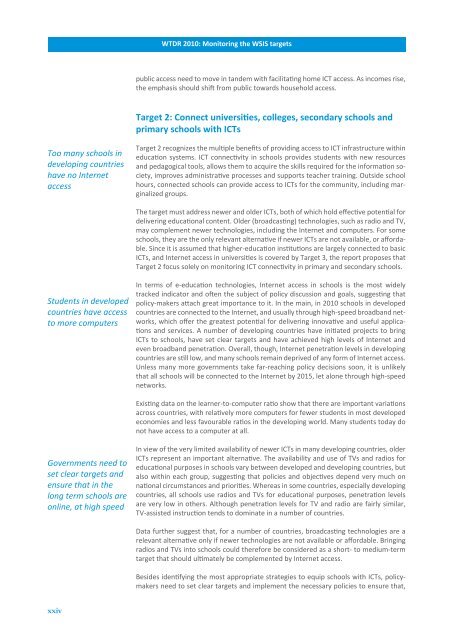Monitoring the WSIS targets
Monitoring the WSIS targets
Monitoring the WSIS targets
- No tags were found...
You also want an ePaper? Increase the reach of your titles
YUMPU automatically turns print PDFs into web optimized ePapers that Google loves.
WTDR 2010: <strong>Monitoring</strong> <strong>the</strong> <strong>WSIS</strong> <strong>targets</strong>public access need to move in tandem with facilitating home ICT access. As incomes rise,<strong>the</strong> emphasis should shift from public towards household access.Target 2: Connect universities, colleges, secondary schools andprimary schools with ICTsToo many schools indeveloping countrieshave no InternetaccessTarget 2 recognizes <strong>the</strong> multiple benefits of providing access to ICT infrastructure withineducation systems. ICT connectivity in schools provides students with new resourcesand pedagogical tools, allows <strong>the</strong>m to acquire <strong>the</strong> skills required for <strong>the</strong> information society,improves administrative processes and supports teacher training. Outside schoolhours, connected schools can provide access to ICTs for <strong>the</strong> community, including marginalizedgroups.The target must address newer and older ICTs, both of which hold effective potential fordelivering educational content. Older (broadcasting) technologies, such as radio and TV,may complement newer technologies, including <strong>the</strong> Internet and computers. For someschools, <strong>the</strong>y are <strong>the</strong> only relevant alternative if newer ICTs are not available, or affordable.Since it is assumed that higher-education institutions are largely connected to basicICTs, and Internet access in universities is covered by Target 3, <strong>the</strong> report proposes thatTarget 2 focus solely on monitoring ICT connectivity in primary and secondary schools.Students in developedcountries have accessto more computersIn terms of e-education technologies, Internet access in schools is <strong>the</strong> most widelytracked indicator and often <strong>the</strong> subject of policy discussion and goals, suggesting thatpolicy-makers attach great importance to it. In <strong>the</strong> main, in 2010 schools in developedcountries are connected to <strong>the</strong> Internet, and usually through high-speed broadband networks,which offer <strong>the</strong> greatest potential for delivering innovative and useful applicationsand services. A number of developing countries have initiated projects to bringICTs to schools, have set clear <strong>targets</strong> and have achieved high levels of Internet andeven broadband penetration. Overall, though, Internet penetration levels in developingcountries are still low, and many schools remain deprived of any form of Internet access.Unless many more governments take far-reaching policy decisions soon, it is unlikelythat all schools will be connected to <strong>the</strong> Internet by 2015, let alone through high-speednetworks.Existing data on <strong>the</strong> learner-to-computer ratio show that <strong>the</strong>re are important variationsacross countries, with relatively more computers for fewer students in most developedeconomies and less favourable ratios in <strong>the</strong> developing world. Many students today donot have access to a computer at all.Governments need toset clear <strong>targets</strong> andensure that in <strong>the</strong>long term schools areonline, at high speedIn view of <strong>the</strong> very limited availability of newer ICTs in many developing countries, olderICTs represent an important alternative. The availability and use of TVs and radios foreducational purposes in schools vary between developed and developing countries, butalso within each group, suggesting that policies and objectives depend very much onnational circumstances and priorities. Whereas in some countries, especially developingcountries, all schools use radios and TVs for educational purposes, penetration levelsare very low in o<strong>the</strong>rs. Although penetration levels for TV and radio are fairly similar,TV-assisted instruction tends to dominate in a number of countries.Data fur<strong>the</strong>r suggest that, for a number of countries, broadcasting technologies are arelevant alternative only if newer technologies are not available or affordable. Bringingradios and TVs into schools could <strong>the</strong>refore be considered as a short- to medium-termtarget that should ultimately be complemented by Internet access.Besides identifying <strong>the</strong> most appropriate strategies to equip schools with ICTs, policymakersneed to set clear <strong>targets</strong> and implement <strong>the</strong> necessary policies to ensure that,xxiv
















